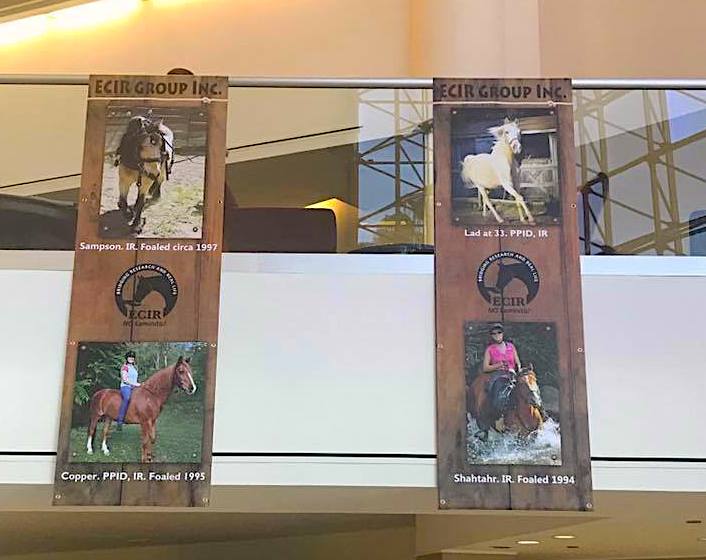ECIR Group Inc. Concludes Successful 2017 NO Laminitis! Conference
11/15/2017

Tucson, AZ — Since 1999, the ECIR Group has improved the welfare of equines with metabolic disorders by focusing on prevention and treatment of endocrinopathic laminitis. Helping caregivers learn to recognize the importance of diagnosis, diet and drugs if needed, trim, and exercise, has successfully seen thousands through the complications of Equine Cushing’s Disease and Insulin Resistance. Updated research and protocols for prevention and rehabilitation from endocrinopathic laminitis were enthusiastically received by 190 horse owners, veterinarians, farriers, and trimmers at the recent 2017 NO Laminitis Conference, held at the Tucson Hilton East, October 27-29.
The 2017 attendance represented a 15% increase over the 2015 Conference. Many were attendees returning for their second, third, or fourth time; 125 people were first-time NO Laminitis! Conference attendees.
Approaches to and protocols for the management of diagnosis, nutrition, trim, and exercise that have been successfully trialed in real-life situations have broadened the ability to recognize and to treat Pituitary Pars intermedia Dysfunction (PPID) and Insulin Resistance (IR), often before it leads to laminitis. Lectures from researchers and practitioners on the ground with the horses and their owners, reviewed the need for early recognition of often confusing or overlooked signs and symptoms.
Former Houston Police Department Mounted Patrol member, Greg Sokoloski, has taken the ECIR concepts and protocols to his new position with Panther Creek Inspiration Ranch, saying, “I attended the conference in 2015 and could not wait for this one in 2017.” He noted that, “This year was again very fulfilling in keeping up with the health of our horses. The speakers are passionate about their responsibilities in keeping the health of horses worldwide a priority and continue to keep the humans informed about the issues we face with them.”
Once thought to be a death sentence, treatment for endocrinopathic laminitis can be successful. Why it is different and what modalities actually work in the field for pain relief and rehabilitation were a large part of the two-and-a-half day conference.
Farrier Pete Ramey explained it this way: “Too many times, I have spent my CE dollars and come home with nothing that I could take to the horse. Not this time.” He added a prediction for the future, saying, “I got such an increased understanding of PPID, IR, and laminitis. Plus, more than a dozen new ideas I want to try out in the dirt. I have a feeling that 10 years from now, looking back, this weekend will have been a "turning point" -- a defining moment in my own learning process and skill level.”
Four lecturers presented aspect of the equine foot, from day-to-day presentation and dietary impact, through a review of the soft tissues and internal mechanisms, to the recognition of early impact on a cellular level.
Stated Dr. Heather Fowler, "My husband, also a vet, came with me for the first time. We were mentally tired each night processing so much wonderful information…. The whole way home we were talking back and forth about things we learned, things we wanted to do differently or better, options and ideas we were excited about.” She went on to say that, "Hearing all the different perspectives on the same topic really pulled things together for me. One example out of many: Combining Paige Poss's elegant hoof dissection photos with Dr. Bowker's histopathology slides was very powerful in helping me better understand hoof anatomy and physiology. It was wonderful!”
Traveling from the UK, Sarah Braithwaite, owner of ForagePlus and an ECIR Group Benefactor, shared her experience: “This was the third time I have flown across the Atlantic pond to attend this conference and it has been brilliant to see that each year the conference grows in numbers. More vets, more hoof care specialists, more people from around the world who have experienced or heard about the success of understanding the different causes of laminitis.” Sarah concluded, “I could probably fill a whole book with the information gleaned from my attendance listening to all the speakers, who included Dr. Robert Bowker, Dr. Lisa Lancaster, and Dr. Eleanor Kellon.”
The 2017 NO Laminitis! Conference and the ongoing work of the ECIR Group Inc. are generously supported by 27 businesses, who understand the needs of the members of the ECIR outreach groups and nonprofit. The 2017 ECIR Benefactors may be found at
https://www.ecirhorse.org/benefactors.php
Proceedings from the 2017 NO Laminitis! Conference will be available for free download in late March of 2018. Proceedings from previous 2013 ad 2015 conferences are already available for free download on the International Veterinary Information Service (IVIS) and on the ECIR Group website https://www.ecirhorse.org.
The ECIR Group Inc. will present the next NO Laminitis! Conference in 2019.
XXX
About ECIR Group Inc.
Started in 1999, the ECIR Group is the largest field-trial database for PPID and IR in the world and provides the latest research, diagnosis, and treatment information, in addition to dietary recommendations, for horses with these conditions. Even universities do not and cannot compile and follow long term as many in-depth case histories of PPID/IR horses as the ECIR Group.
In 2013 the Equine Cushing's and Insulin Resistance Group Inc., an Arizona nonprofit corporation, was approved as a 501(c)3 public charity. Tax deductible contributions and grants support ongoing research, education, and awareness of Equine Cushing's Disease/PPID and Insulin Resistance.
THE MISSION of the ECIR Group Inc. is to improve the welfare of equines with metabolic disorders via a unique interface between basic research and real-life clinical experience. Prevention of laminitis is the ultimate goal. The ECIR Group serves the scientific community, practicing clinicians, and owners by focusing on investigations most likely to quickly, immediately, and significantly benefit the welfare of the horse.

